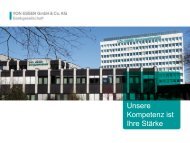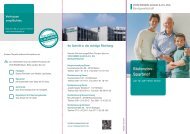2012 Registration document and annual financial report - BNP Paribas
2012 Registration document and annual financial report - BNP Paribas
2012 Registration document and annual financial report - BNP Paribas
- No tags were found...
Create successful ePaper yourself
Turn your PDF publications into a flip-book with our unique Google optimized e-Paper software.
5RISKSAND CAPITAL ADEQUACYCredit riskRisk-weighted credit exposures fell by EUR -36 billion, mainly as a resultof the deleveraging policy adopted by the Group ahead of the new CRD 4regulation. Most of the EUR 16 billion negative volume effect stemmedfrom CIB’s Corporate Banking activities, mainly due to the adjustmentplan pursued during the first nine months of <strong>2012</strong> (EUR 3 billion of assetsales <strong>and</strong> EUR 7 billion reduction in loan at origination). The disposalof Klépierre accounted for most of the scope effect <strong>and</strong> the residualinterest has been weighted as equity risk exposure. The method effectmainly stems from changes in approach used (transition to IRBA) notablyfollowing the legal merger of Banque de Bretagne with <strong>BNP</strong> <strong>Paribas</strong> SA.CREDIT RISK: I NTERNAL RATINGS BASED APPROACH (IRBA)5The internal rating system developed by the Group covers the entireBank. The IRBA, validated in December 2007, covers the Corporate<strong>and</strong> Investment Banking (CIB) portfolio, the French Retail Banking(FRB) portfolio, <strong>BNP</strong> <strong>Paribas</strong> Securities Services (BP2S), a part of<strong>BNP</strong> <strong>Paribas</strong> Personal Finance as well as the entities of the subgroups<strong>BNP</strong> <strong>Paribas</strong> Fortis <strong>and</strong> BGL <strong>BNP</strong> <strong>Paribas</strong>.CORPORATE MODEL [A udited]The IRBA for the Corporate book (i.e. institutions, corporates, specialisedfinancing <strong>and</strong> sovereigns) is based on a consistent rating procedurein which GRM has the final say regarding the rating assigned to thecounterparty <strong>and</strong> the Global Recovery Rate (GRR) assigned to transactions.Credit Conversion Factors (CCF) of off-balance sheet transactions areassigned according to counterparty <strong>and</strong> transaction type.The generic process for assigning a rating to each segment of theCorporate book is as follows:■ for corporates <strong>and</strong> structured financing, an analysis is carried out bythe unit proposing a rating <strong>and</strong> a Global Recovery Rate to the CreditCommittee, using the rating models <strong>and</strong> tools developed by GRM. Therating <strong>and</strong> Global Recovery Rate are validated or revised by the GRMrepresentative during the Credit Committee meeting. The committeedecides whether or not to grant or renew a loan <strong>and</strong>, if applicable,reviews the counterparty rating at least once a year;■ for banks, the analysis is carried out by analysts in the RiskManagement Function. Counterparty ratings <strong>and</strong> Global RecoveryRates are determined during review committees by geographical areato ensure comparability between similar banks;■ for sovereigns, the ratings are proposed by the Economic ResearchDepartment <strong>and</strong> approved at Country Committee meetings which takeplace several times a year. The committee comprises members ofExecutive Management, the Risk Management Department <strong>and</strong> theBusiness Lines;■ for medium-sized companies, a score is assigned by the business line’scredit analysts <strong>and</strong> GRM has the final say;■ for each of these sub-portfolios, the risk parameters are measuredusing a model certified <strong>and</strong> validated by the GRM teams, based mainlyon an analysis of the Bank’s historical data. The model is supportedas far as possible by tools available through a network to ensureconsistent use. However, expert judgment remains an indispensablefactor. Each rating <strong>and</strong> recovery rate is subject to an opinion whichmay differ from the results of the model, provided it can be justified.The method of measuring risk parameters is based on a set of commonprinciples, <strong>and</strong> particularly the “two pairs of eyes” principle whichrequires at least two people, at least one of whom has no commercialinvolvement, to give their opinion on each counterparty rating <strong>and</strong> eachtransaction Global Recovery Rate.The same definition of default is used consistently throughout the Groupfor each asset class. For local counterparties (SMEs, local authorities),this definition may be adapted slightly to meet any specific localregulatory requirements, particularly as regards the length of past-dueor the materiality threshold.The chart below shows a breakdown by credit rating of performing loans<strong>and</strong> commitments in the Corporate book (asset classes: corporates,central governments <strong>and</strong> central banks, institutions) for all the Group’sbusiness lines, measured using the Internal Ratings-Based Approach.This exposure represented EUR 587 billion of the gross credit risk at31 December <strong>2012</strong> compared with EUR 627 billion at 31 December 2011.The majority of commitments are towards borrowers rated as good orexcellent quality, reflecting the heavy weighting of large multinationalgroups <strong>and</strong> <strong>financial</strong> institutions in the Bank’s client base. A significantproportion of commitments to non-investment grade borrowers arehighly structured or secured by high quality guarantees implying ahigh recovery rate in the event of default. They include export financingcovered by export credit insurance written by international agencies,project finance, structured finance <strong>and</strong> transaction financing.254<strong>2012</strong> <strong>Registration</strong> <strong>document</strong> <strong>and</strong> <strong>annual</strong> <strong>financial</strong> <strong>report</strong> - <strong>BNP</strong> PARIBAS





